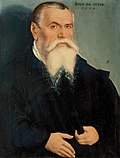File:Lucretia (Lucas Cranach d.ä.) - Nationalmuseum - 18083 - crop.jpg

Original file (855 × 2,046 pixels, file size: 625 KB, MIME type: image/jpeg)
Captions
Captions
Summary
[edit]| Lucas Cranach the Elder: Lucretia
|
|||||||||||||||||||||||||||
|---|---|---|---|---|---|---|---|---|---|---|---|---|---|---|---|---|---|---|---|---|---|---|---|---|---|---|---|
| Artist |
artist QS:P170,Q191748 |
||||||||||||||||||||||||||
| Depicted people InfoField | Lucretia | ||||||||||||||||||||||||||
| Title |
English: Lucretia Svenska: Lucretia |
||||||||||||||||||||||||||
| Object type |
painting object_type QS:P31,Q3305213 |
||||||||||||||||||||||||||
| Genre |
nude |
||||||||||||||||||||||||||
| Description |
English: According to tradition, Lucretia was a beautiful noblewoman of ancient Rome. She was the virtuous wife of Lucius Tarquinius Collatinus, whose uncle was the last king of the city. Lucretia took her own life after being raped by one of the
king’s sons. The incident is said to have sparked a revolt in which the royal family was overthrown, marking the start of the Roman Republic. It was a subject the German Renaissance artist Lucas Cranach the Elder and his contemporaries frequently returned to. This painting probably belonged to King Gustav Vasa’s collection of art.Svenska: Lucretia var enligt traditionen en vacker adelsdam i antikens Rom. Hon var dygdig hustru till Lucius Tarquinius Collatinus, vars farbror var rikets siste kung. Lucretia tog sitt liv efter att ha blivit våldtagen av en av kungasönerna. Händelsen ska ha bidragit till en revolt där kungafamiljen störtades, vilket blev början på den romerska republiken. Den tyske renässanskonstnären Lucas Cranach d.ä. och hans samtida konstnärskollegor återvände många gånger till motivet. Målningen ingick i Gustav Vasas konstsamling. |
||||||||||||||||||||||||||
| Depicted people |
Lucretia |
||||||||||||||||||||||||||
| Original caption InfoField | English: According to tradition, Lucretia was a beautiful noblewoman of ancient Rome. She was the virtuous wife of Lucius Tarquinius Collatinus, whose uncle was the last king of the city. Lucretia took her own life after being raped by one of the
king’s sons. The incident is said to have sparked a revolt in which the royal family was overthrown, marking the start of the Roman Republic. It was a subject the German Renaissance artist Lucas Cranach the Elder and his contemporaries frequently returned to. This painting probably belonged to King Gustav Vasa’s collection of art.Svenska: Lucretia var enligt traditionen en vacker adelsdam i antikens Rom. Hon var dygdig hustru till Lucius Tarquinius Collatinus, vars farbror var rikets siste kung. Lucretia tog sitt liv efter att ha blivit våldtagen av en av kungasönerna. Händelsen ska ha bidragit till en revolt där kungafamiljen störtades, vilket blev början på den romerska republiken. Den tyske renässanskonstnären Lucas Cranach d.ä. och hans samtida konstnärskollegor återvände många gånger till motivet. Målningen ingick i Gustav Vasas konstsamling. |
||||||||||||||||||||||||||
| Date |
1528 date QS:P571,+1528-00-00T00:00:00Z/9 |
||||||||||||||||||||||||||
| Medium |
English: Oil on wood Svenska: Olja på trä |
||||||||||||||||||||||||||
| Dimensions |
|
||||||||||||||||||||||||||
| Collection |
institution QS:P195,Q842858 |
||||||||||||||||||||||||||
| Accession number |
NM 1080 |
||||||||||||||||||||||||||
| Exhibition history |
|
||||||||||||||||||||||||||
| Inscriptions |
Svenska: Signerad: 1528 (med mästarmärke, en bevingad orm) |
||||||||||||||||||||||||||
| References | |||||||||||||||||||||||||||
| Source/Photographer | Erik Cornelius / Nationalmuseum | ||||||||||||||||||||||||||
| Permission (Reusing this file) |
|
||||||||||||||||||||||||||
File history
Click on a date/time to view the file as it appeared at that time.
| Date/Time | Thumbnail | Dimensions | User | Comment | |
|---|---|---|---|---|---|
| current | 11:54, 2 March 2018 |  | 855 × 2,046 (625 KB) | Shakko (talk | contribs) | {{Artwork |other_fields_1 = {{depicted person|Lucretia|style=information field}} |artist = {{Creator:Lucas Cranach (I)}} |title = {{en|Lucretia}} {{sv|Lucretia}} |wikidata = Q18573609 |object_type = painting |description = {{en|According to tradition, Lucretia was a beautiful noblewoman of ancient Rome. She was the virtuous wife of Lucius Tarquinius Collatinus, whose uncle was the last king of the city. Lucretia took her own life after being raped by one of the king’s sons. The incident is said to have sparked a revolt in which the royal family was overthrown, marking the start of the Roman Republic. It was a subject the German Renaissance artist Lucas Cranach the Elder and his contemporaries frequently returned to. This painting probably belonged to King Gustav Vasa’s collection of art.}} {{sv|Lucretia var enligt traditionen en vacker adelsdam i antikens Rom. Hon var dygdig hustru till Lucius Tar... |
You cannot overwrite this file.
File usage on Commons
The following 4 pages use this file:
Metadata
This file contains additional information such as Exif metadata which may have been added by the digital camera, scanner, or software program used to create or digitize it. If the file has been modified from its original state, some details such as the timestamp may not fully reflect those of the original file. The timestamp is only as accurate as the clock in the camera, and it may be completely wrong.
| Copyright holder |
|
|---|---|
| Image title |
|
| Orientation | Normal |
| Horizontal resolution | 300 dpi |
| Vertical resolution | 300 dpi |
| Software used | ACDSee Pro 6 |
| File change date and time | 14:53, 2 March 2018 |
| Y and C positioning | Centered |
| Exif version | 2.21 |
| DateTime subseconds | 438 |
| Color space | Uncalibrated |
| Unique ID of original document | adobe:docid:photoshop:7f99560f-fdb4-11d8-9971-f2b59617d303 |
| Copyright status | Copyrighted |
| Date metadata was last modified | 14:13, 10 February 2014 |
Structured data
- Information field template with formatting
- Content made available through Wikimedia Sverige partnerships
- CC-PD-Mark
- PD-old-100
- Images from the Nationalmuseum Stockholm
- PD-Art (PD-old-auto)
- Licensed-PD-Art missing SDC copyright license
- Artworks with known accession number
- Artworks with Wikidata item
- Artworks digital representation of 2D work
- Media contributed by Nationalmuseum Stockholm: 2016-10
- Files, uploaded by Shakko from various sources





